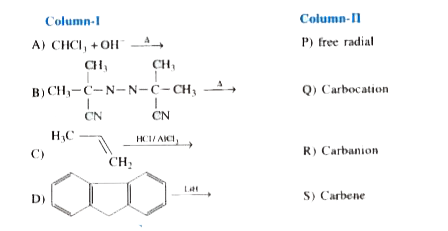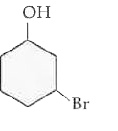(CH3)2C=CH−CH3∣CH−CH=C(CH3)2 What is the systematic name of the above mentioned structure?Solution in Telugu
The given compound can be written as
CH31−CH3∣C2=CH3−CH3∣CH4−CH5=CH3∣C6−CH37
The systematic name is 2, 4, 6-Trimethyl-2, 5-heptadiene
Topper's Solved these Questions
- BOOK - AAKASH SERIESCHAPTER - GENERAL ORGANIC CHEMISTRYEXERCISE - Subjective Exercise -111videos
GENERAL ORGANIC CHEMISTRY
- BOOK - AAKASH SERIESCHAPTER - GENERAL ORGANIC CHEMISTRYEXERCISE - Subjective Exercise -26videos
GENERAL ORGANIC CHEMISTRY
- BOOK - AAKASH SERIESCHAPTER - ENVIRONMENTAL CHEMISTRYEXERCISE - EXERCISE ON PASSAGE (PASSAGE-III)5videos
ENVIRONMENTAL CHEMISTRY
- BOOK - AAKASH SERIESCHAPTER - HYDROCARBONSEXERCISE - ADDITIONAL PRACTICE SHEET ( LEVEL-II (PRACTICE SHEET (ADVANCED) (MATRIX MATCHING TYPE QUESTIONS)))5videos
HYDROCARBONS
Similar Questions
Explain the structures of CH4andC2H6.
05:48View SolutionExplain the classification of hydrocarbons.
04:23View SolutionOzone layer acts as one of the most important life support system. The major cause of ozone layer destruction is believed to be the release of chlorofluorocarbon compounds. UV radiation causes the chlorofluouocarbons to dissociate : CF2Clhv−−→Cl⋅+CF2CI A highly reactive chlorine atomis responsible for the decomposition of ozone. Cl⋅+O3(g)→ClO⋅+O2(g)ClO⋅+O(g)→Cl⋅+O2(g) Free radicals of chlorine decompose ozone molecules in a chain reaction. The depletion of ozone layer leading to ozone hole has, however, been mainly observed in the stratosphere over Antarctica. Special type of cloud called polar stratospheric colouds are formed over Antarctica.These clouds (contain solid HNO3.3H2O) play an important role in ozone depletion.
ClO⋅+NO2→ClONO2
ClONO2+H2O→HOCl+HNO3
ClONO2+HCl→Cl2+HNO3
HOClhv−−→HO⋅+Cl⋅
The reactive chlorine atoms thus formed are rendered to deplete ozone layer.
The ozone layer is present in :02:07View SolutionMatch the intermediates formed in the reaction.
 02:10View Solution
02:10View SolutionGiven the IUPAC names of the following compounds: (i) CH_(3)CH_(2)CH_(2)underset(C_(2)H_(5))underset(|)overset(CH_(3))underset(|)(C )CH_(2)-overset(CH_(3))overset(|)(C )=CH_(2) (ii) CH_(3)-overset(CH_(3))overset(C )H-C-=CH (iii) C_(6)H_(5)-CH=CH-CH_(2)Cl CH_(3)CH-CH-CH_(2)Cl (iv) CH_(3)CH=CH-CH_(2)Br v CH_(2)=CH-overset(Cl)overset(|)(C )-CH=CH_(2) vi CH_(2)=CH-overset(CH_(2)CH_(3))underset(|)(C )H-underset(Cl)underset(|)(C )=CH_(2) vii. (CH_(3))_(3)C - CH=CH_(2)
02:25View SolutionWrite the IUPAc name of the following compound :
(a) CH3−CH2−CH3∣CH−CH=CH−CH2−CH3
(b) CH3−CH2−CH3∣CH−CH2−CH3∣CH−CH∣CH2∣CH2∣CH−CH3∣CH3−CH=CH3∣C−CH301:21View SolutionCH_(3)-underset(CH_(3))underset(|)(CH)-CH=CH-CH_(2)-overset(O)overset(||)(C)-OH
View SolutionThe IUPAC name of
CH2=CH−CH(CH3CH2)Br∣C=CH2 is :View SolutionGive the IUPAC names of the following :
(i) CH3−CH=CH−CH=CH2
(ii) CH3−CH2−CHO
(iii) CH−O∣∣C−CH2−CH3View SolutionThe IUPAC name of the compound
CH3−CH3∣CH−CH3∣CH−CH(CH2CH2CH2CH3)204:45View SolutionThe IUPAC name of the compound CH_(3)CH_(2)CH_(2)underset(CH(CH_(3))_(2))underset(|)(CH)-overset(CH_(3))overset(|)(CH)-underset(CH_(2)CH_(3))underset(|)overset(CH_(2)CH_(3))overset(|)(C)-CH_(2)CH_(3)
03:28View SolutionCH3−CH3∣CH−CH3∣CH−CH(CH2CH2CH3)2
01:24View SolutionWrite the IUPAC names of the following compounds: (i) (C_(2)H_(5))_(2)CH-CH=CH_(2) (ii) CH_(2)=CH-overset(C_(2)H_(5))overset(|)(C)H-CH_(2)-C-=CH (iii) CH_(2)=underset(C(CH_(3))_(2))underset(|)(C)-CH_(2)-CH_(3) (iv) CH_(3)-CH=CH-C-=CH (v) CH_(2)=CH-overset(CH_(3))overset(|)(C)H-CH_(2)-CH=CH_(2) (vi) CH_(3)CH_(2)C-=underset(H_(2)C=CH)underset(|)(C CH)-CH_(2)CH(CH_(3))_(2) (vii) CH_(3)CH_(2)CH_(2)overset(CH=CH_(2))overset(|)(C)HCH_(2)CH_(2)CH_(2)CH_(3) (viii) CH_(2)=CH-overset(CH_(3))overset(|)(C)H-overset(CH_(2))overset(||)(C)-CH_(2)-C-=CH (ix) HC-=C-C=CH-CH=CH_(2) (x) CH_(2)=C=CH-CH_(2)-underset(CH=CH_(2))underset(|)(C)H-CH_(3)
View SolutionThe most suitable reagent for the following conversion ? CH_(3)-CH=CH-CH_(2)-overset(O)overset(||)C-CH_(3)toCH_(3)-CH=CH-CH_(2)-overset(O)overset(||)C-OH .
13:05View SolutionName the following compounds according to IUPAC system.
(i) CH3−CH2−CH∣CH2Cl−CH2OH∣CH−CH∣CH3−CH3
(ii) CH3−CH3∣CH−CH2−OH∣CH−CH2OH∣CH−CH3

(iv) H2C=CH−CH∣OH−CH2−CH2−OH
(v) CH2−C∣CH3=C∣Br−CH2OHView Solution

